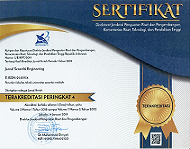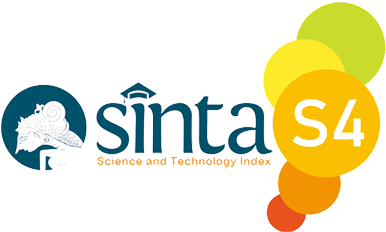Integrasi Lean DMAIC dan Circular Economy untuk Reduksi Waste pada Manufaktur Paving Block
Keywords:
Lean DMAIC, waste, paving block, defects, dead stockAbstract
Waste is a significant challenge in the manufacturing industry, including small and medium enterprises (SMEs) engaged in paving block production. This study applies the Lean DMAIC (Define–Measure–Analyse–Improve–Control) methodology to identify, analyze, and reduce waste in the production process. A case study was conducted at a paving block factory in East Java, which has an annual production capacity of 119,400 m². Data were collected from production records, observations, and interviews conducted between September 2024 and August 2025. Analysis using a weighted Pareto diagram and Flow Process Mapping revealed that defect categories, although accounting for only 1.99% of total production, resulted in a significant accumulation of dead stock in the storage area. Through a Decision Matrix and a radar chart, a recycling strategy was selected as the improvement solution. This strategy was subsequently formalized into a Standard Operating Procedure (SOP) for managing rejected products, ensuring consistent implementation and adherence. Evaluation of the implementation over one month showed a 23.8% reduction in dead stock volume. These findings provide empirical evidence of the effectiveness of integrating Lean DMAIC with circular economy principles in the paving block industry, offering a practical framework that can be replicated in similar manufacturing sectors.
References
[1] W. Abualfaraa, K. Salonitis, A. Al-Ashaab, and M. Ala’raj, “Lean-Green Manufacturing Practices and Their Link with Sustainability: A Critical Review,” Sustainability, vol. 12, no. 3, p. 981, Jan. 2020, doi: 10.3390/su12030981.
[2] R. Novitasari and I. Iftadi, “Analisis Lean Manufacturing untuk Minimasi Waste pada Proses Door PU,” Jurnal INTECH Teknik Industri Universitas Serang Raya, vol. 6, no. 1, pp. 65–74, Jun. 2020, doi: 10.30656/intech.v6i1.2045.
[3] A. Palange and P. Dhatrak, “Lean manufacturing a vital tool to enhance productivity in manufacturing,” Mater Today Proc, vol. 46, pp. 729–736, 2021, doi: 10.1016/j.matpr.2020.12.193.
[4] J. P. Womack and D. T. Jones, “Lean Thinking—Banish Waste and Create Wealth in your Corporation,” Journal of the Operational Research Society, vol. 48, no. 11, pp. 1148–1148, Dec. 1997, doi: 10.1038/sj.jors.2600967.
[5] J. Antony, R. Snee, and R. Hoerl, “Lean Six Sigma: yesterday, today and tomorrow,” International Journal of Quality & Reliability Management, vol. 34, no. 7, pp. 1073–1093, Aug. 2017, doi: 10.1108/IJQRM-03-2016-0035.
[6] M. Lande, R. L. Shrivastava, and D. Seth, “Critical success factors for Lean Six Sigma in SMEs (small and medium enterprises),” The TQM Journal, vol. 28, no. 4, pp. 613–635, Jun. 2016, doi: 10.1108/TQM-12-2014-0107.
[7] D. C. Deselnicu, G. Militaru, V. Deselnicu, G. Zăinescu, and L. Albu, “Towards a circular economy– a zero waste programme for europe,” in 7th International Conference on Advanced Materials and Systems, ICAMS 2018, L. Albu and V. Deselnicu, Eds., Inst. Nat. Cercetare-Dezvoltare Text. Pielarie, 2018, pp. 563–568. doi: 10.24264/icams-2018.XI.4.
[8] M. Geissdoerfer, M. P. P. Pieroni, D. C. A. Pigosso, and K. Soufani, “Circular business models: A review,” J Clean Prod, vol. 277, p. 123741, Dec. 2020, doi: 10.1016/j.jclepro.2020.123741.
[9] P. Ghisellini, C. Cialani, and S. Ulgiati, “A review on circular economy: the expected transition to a balanced interplay of environmental and economic systems,” J Clean Prod, vol. 114, pp. 11–32, Feb. 2016, doi: 10.1016/j.jclepro.2015.09.007.
[10] The Ellen MacArthur Foundation, “Cities and Circular Economy for Food,” 2019. Accessed: Oct. 16, 2022. [Online]. Available: https://ellenmacarthurfoundation.org/
[11] W. Niyommaneerat, K. Suwanteep, and O. Chavalparit, “Sustainability indicators to achieve a circular economy: A case study of renewable energy and plastic waste recycling corporate social responsibility (CSR) projects in Thailand,” J Clean Prod, vol. 391, p. 136203, Mar. 2023, doi: 10.1016/j.jclepro.2023.136203.
[12] T. Ohno, Toyota Production System: Beyond Large-Scale Production. CRC Press, 1988.
[13] J. Bhamu and K. Singh Sangwan, “Lean manufacturing: literature review and research issues,” International Journal of Operations & Production Management, vol. 34, no. 7, pp. 876–940, Jul. 2014, doi: 10.1108/IJOPM-08-2012-0315.
[14] A. Elkhairi, F. Fedouaki, and S. El Alami, “Barriers and Critical Success Factors for Implementing Lean Manufacturing in SMEs,” IFAC-PapersOnLine, vol. 52, no. 13, pp. 565–570, 2019, doi: 10.1016/j.ifacol.2019.11.303.
[15] N. A. Panayiotou and K. E. Stergiou, “A systematic literature review of lean six sigma adoption in European organizations,” International Journal of Lean Six Sigma, vol. 12, no. 2, pp. 264–292, Mar. 2021, doi: 10.1108/IJLSS-07-2019-0084.
[16] M. Geissdoerfer, P. Savaget, N. M. P. Bocken, and E. J. Hultink, “The Circular Economy – A new sustainability paradigm?,” J Clean Prod, vol. 143, pp. 757–768, Feb. 2017, doi: 10.1016/j.jclepro.2016.12.048.
[17] V. Ranta, L. Aarikka-Stenroos, and S. J. Mäkinen, “Creating value in the circular economy: A structured multiple-case analysis of business models,” J Clean Prod, vol. 201, pp. 988–1000, Nov. 2018, doi: 10.1016/j.jclepro.2018.08.072.
[18] J. A. Garza-Reyes, “Lean and green – a systematic review of the state of the art literature,” J Clean Prod, vol. 102, pp. 18–29, Sep. 2015, doi: 10.1016/j.jclepro.2015.04.064.
[19] M. P. P. Pieroni, T. C. McAloone, and D. C. A. Pigosso, “Business model innovation for circular economy and sustainability: A review of approaches,” J Clean Prod, vol. 215, pp. 198–216, Apr. 2019, doi: 10.1016/j.jclepro.2019.01.036.
[20] A. F. Fudhla, B. Wirjodirdjo, and M. L. Singgih, “Integrating Reverse Cycle Strategy in Circular Business Model Innovation: A Case Study,” Foresight and STI Governance, vol. 18, no. 3, pp. 84–103, Sep. 2024, doi: 10.17323/2500-2597.2024.3.84.103.
[21] J. Huang, M. Irfan, S. S. Fatima, and R. M. Shahid, “The role of lean six sigma in driving sustainable manufacturing practices: an analysis of the relationship between lean six sigma principles, data-driven decision making, and environmental performance,” Front Environ Sci, vol. 11, Jun. 2023, doi: 10.3389/fenvs.2023.1184488.
Downloads
Published
Issue
Section
License
Copyright (c) 2025 Dini Retnowati, Ahmad Fatih Fudhla, Asri Dwi Puspita, Sofia Annurrada (Author)

This work is licensed under a Creative Commons Attribution 4.0 International License.












